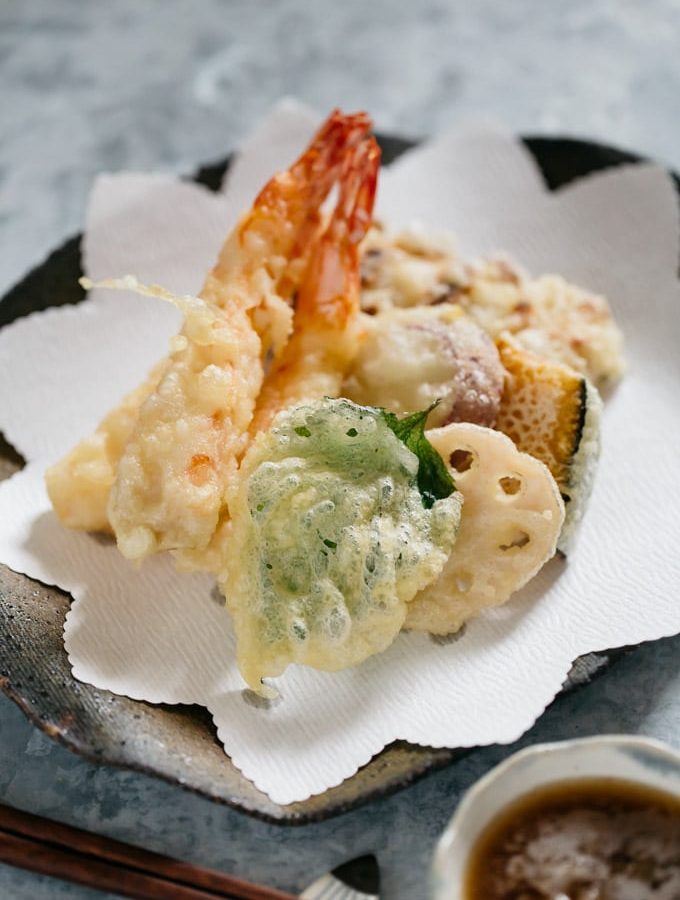RE-ENVISION: Tempura
RE-ENVISION is an ongoing series of research memos produced by our associates at Appetite. We trace the cultural genealogies of food from around the world to challenge commonly held beliefs about origin and authenticity.
Tempura is a common Japanese dish that utilises fritter-cooking techniques. Generally, fillings such as seafood or vegetables are dipped in a batter composed of egg, flour, and cold water and then deep fried in oil.1 When frying, timing is essential. It is imperative that the end result is as “light” as possible to prevent the dish from tasting too oily. Additionally, the oil type determines the tempura’s colour. In Tokyo, tempura has a light gold appearance, whereas in Osaka, it is snow-white.
In our investigation, we found that deep-drying was not a Japanese cooking technique.2 In fact, this cooking method has been around for millennia and originated in Greece during the 5th century BCE, where frying food in olive oil was the norm. This practice is still continued in Greece today in dishes like kalamarakia, a deep fried squid sliced in rings. Due to population migrations, this cooking method has spread all over Europe.
Unbeknownst to many, tempura was first introduced to the Japanese by the Portuguese.3 In 1543 three Portuguese sailors arrived in Tanegashima, a small Japanese island, by accident. They were sailing along the Chinese coast, but due to stormy weather drifted to this undiscovered island.
At that time, the Japanese were in the middle of a civil war and in need of weapons. The Portuguese took advantage of the opportunity and supplied Japanese soldiers with firearms in return for goods. Since the Portuguese cargo ships also docked in China, they also brought the Japanese many Chinese goods like silk and porcelain. These successful interactions eventually led to the creation of a short-lived trading post in Japan. In 1639, Japanese emperor Tokugawa Iemitsu banished the Portuguese, suspecting Christianity to be a major threat to Japanese society.
During their short stint, however, the Portuguese introduced a dish called peixinhos da horta, a battered and fried green bean dish, to the Japanese community.4 Peixinhos da horta, which literally translates to fish from the garden because of its colourful and fish-like appearance, was a completely novel and original addition to Japanese cuisine. Fried food items were not common on the island at all, but its popularity led to the development of a Japanese analogue: tempura. This time, with a lighter batter and new fillings like seafood, potatoes, and mushrooms.
The word tempura is derived from the latin word tempora, which refers to the passage of time.5 Portuguese missionaries utilised the word tempora to refer to the Ember days, a time period in which Catholics were not allowed to eat meat. Thus, peixinhos da horta was consumed as a substitute meat dish.
When tempura was first consumed in Japan, it was considered a dish for the upper class because of the high costs of cooking oil.6 During the Edo period (1603-1868), however, the use of cooking oil became widespread and tempura became the ubiquitous Japanese dish that it is today.
Written by Richard Shim.
Notes
1 Samantha. “Tempura: The Japanese Fried Food With a Surprising Origin.” Asahi Imports, March 20, 2015. https://asahiimports.com/2015/03/20/tempura-the-japanese-fried-food-with-a-surprising-origin/.
2 Lidin, Olof G. “Tanegashima – The Arrival of Europe in Japan.,” 2003. http://www.diva-portal.org/smash/get/diva2:789497/FULLTEXT01.pdf
3 Farley, David. “Travel – The Truth about Japanese Tempura.” BBC. BBC, August 10, 2017. http://www.bbc.com/travel/story/20170808-the-truth-about-japanese-tempura.
4 Swathi, and Ambujom Saraswathy. “Fried Green Beans Portuguese Style/ Peixinhos Da Horta.” Zesty South Indian Kitchen, January 3, 2010. https://zestysouthindiankitchen.com/fried-green-beans-portuguese-style/.
5 Samantha. “Tempura: The Japanese Fried Food With a Surprising Origin.” Asahi Imports, March 20, 2015. https://asahiimports.com/2015/03/20/tempura-the-japanese-fried-food-with-a-surprising-origin/.
6 Nico. “Tempura – How To Enjoy One of Japan’s Most Popular Dishes: Matcha – Japan Travel Web Magazine.” Matcha, November 13, 2017. https://matcha-jp.com/en/2947.

